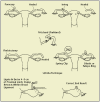Sterilization in the United States
Abstract
Unintended pregnancies are expensive for patients and for society in terms of medical costs, the cost of caring for more children, and the cost to personal and professional goals. Sterilization is the most common contraceptive method utilized by couples in the United States. Given technological advances over the past few decades, male and female surgical sterilization has become a safe, convenient, easy, and highly effective birth control method for the long term. This article reviews current male and female sterilization options.
Keywords: Sterilization; Transcervical tubal occlusion; Tubal ligation; Vasectomy.
Figures





References
-
- Finer LB, Henshaw SK. Disparities in rates of unintended pregnancy in the United States, 1994 & 2001. Perspect Sex Reprod Health. 2006;38:90–96. - PubMed
-
- Halpern V, Grimes DA, Lopez L, Gallo MF. Strategies to improve adherence and acceptability of hormonal methods for contraception. Cochrane Database Syst Rev. 2006;(1) CD004317. DOI: 10.1002/14651858.CD004317.pub2. - PubMed
-
- Hatcher RA, Trussell J, Stewart F, et al. Contraceptive Techonology. 18th ed. Vol. 549. New York: Ardent Media; 2004.
-
- Mosher WD, Martinez GM, Chandra A, et al. Use of contraception and use of family planning services in the United States: 1982–2002. Adv Data. 2004;350:1–35. - PubMed
-
- Westhoff C, Davis A. Tubal sterilization: focus on the U.S. experience. Fertil Steril. 2000;73:913–922. - PubMed
LinkOut - more resources
Full Text Sources
Miscellaneous
